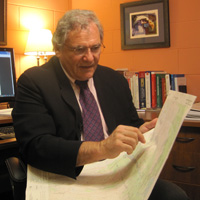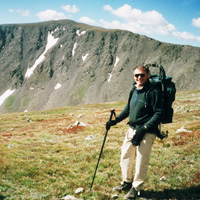Mount William & Mary? The campaign has begun
Ken Kambis is back for round two in his quest to have a Colorado mountain named for William & Mary.
You read that right.
Kambis, a professor of kinesiology and health sciences, assisted Colorado resident Marilyn Brown, who was made an honorary alumna of the university in 2007, in preparing an application to the United States Board on Geographic Names (USBGN). The application asks that a feature known unofficially as South Elbert be officially named Mount William & Mary. That application was filed by Brown on Jan. 7.
{{youtube:medium:center|wsump4HfaAQ, Ken Kambis discusses his experiences on what he hopes will become Mount William & Mary}}
Meanwhile, Kambis, who has conducted extensive high-altitude research on the mountain, is seeking support for this naming. Today, the university e-mailed a letter from President Taylor Reveley to all Colorado-resident alumni asking them to express their support for the renaming to the United States Board on Geographic Names no later than March 1, 2015. However, anyone can participate in the campaign. Personal letters may be mailed to:
Mr. Lou Yost, Executive Secretary
U.S. Board on Geographic Names
U.S. Geological Survey
12201 Sunrise Valley Drive, MS 523
Reston, Virginia 20192-0523
There also is an online petition available.
“We feel a meaningful relationship does exist between our university and Colorado, Lake County in particular,” Reveley wrote. “Just as William & Mary would be honored to have a place named for it in Lake County and Colorado, so the county and state would benefit by association with William & Mary.”
Kambis first climbed the unnamed geographic feature in 1998. He was accompanied by Jack Borgenicht, an octogenarian New Jersey businessman, now deceased, for whom the Borgenicht Altitude Physiology Research Facility in W&M’s Adair Hall is named.
At that time, Borgenicht wanted to climb to the base camp at Mount Everest -- 17,000 feet -- but he became ill. Kambis and he had recently met, and Kambis suggested that they instead complete some high-altitude climbs in Colorado. In 1992, Borgenicht had set the record as the oldest person to climb Washington’s Mount Rainier at the age of 81.
Kambis and Borgenicht returned to Colorado’s Mount Elbert when Borgenicht was 87 and climbed to 13,500 feet. Kambis conducted a pulmonary study during that climb that began at sea level and then spent one day each at Denver (5,250 feet), Vail (7,500 feet), and Leadville (10,120 feet) to finally reach 13,500 feet on Mount Elbert.
On that trip, Kambis and W&M senior instructor of Kinesiology and Health Sciences Kim Whitley also trekked to the top of a 14,134 unnamed geographic feature (two miles away) and placed a William & Mary flag there. Kambis then began formulating a plan to have the site officially named Mount William & Mary.
The idea isn’t as far-fetched as one might think. In Colorado, there is a range of mountains known as the Collegiate Peaks that includes Mount Harvard and Mount Yale, both named in 1869. There’s also a nearby Mount Princeton. Kambis, who has returned to Mount Elbert many times doing research, figured there was no reason why William & Mary shouldn’t join them.
He soon learned that there were some objections to this idea.
“My 1998 application to the U.S. Board on Geographic Names ultimately failed because there was a perception at the time that there wasn’t a significant relationship between the College of William & Mary and the state of Colorado,” Kambis explained. “Also, as an outsider from Virginia, I was considered a carpetbagger coming in trying to name something in Colorado after a Virginia entity.”
There was at least one other possible factor. Colorado is home to 54 “fourteeners” -- mountains standing 14,000 feet or higher above mean sea level.
In 1998, the Colorado Mountain Club required a 100-meter rise for a feature to be considered a separate mountain or peak. This particular geographic feature has about a 90-meter rise from nearby Mount Elbert. So, although it stands 14,134 feet, it doesn’t qualify to be another “fourteener” in the State of Colorado.
Suggesting that the feature be called Mount William & Mary drew the ire of the Colorado Mountain Club, which issued strong opposition to the proposal because of the perception that there was no historical relationship between Colorado and William & Mary. Despite receiving support from former U.S. Senator John Warner, the Forest Service Rangers in Leadville and the Lake County Board of Commissioners, Kambis’ effort unfortunately failed.
 The current application filed by Brown requests reconsideration of Kambis’ original proposal based on what she describes as persuasive new information.
The current application filed by Brown requests reconsideration of Kambis’ original proposal based on what she describes as persuasive new information.
The new strategy is to first point out that there would be no Colorado without the considerable influence of two William & Mary alumni. In 1803, President Thomas Jefferson sent James Monroe and Robert R. Livingston to Paris to negotiate with Napoleon Bonaparte for the purchase of New Orleans. Not only did they come away with that city, but the Purchase also wound up stretching from the Mississippi River to Canada, including most of the Rocky Mountains. The eastern half of what in 1876 would become the state of Colorado was part of this area.
“So without two of our most illustrious alumni, Colorado wouldn’t exist,” Kambis said. “In fact, the connection is so strong and unique that no other university can claim to have the same kind of relationship with Colorado, particularly with the Lake County location of this unnamed geographical feature.
“And the Louisiana Purchase actually makes up the entire area in which the unnamed geographic feature lies. In fact, it constitutes about two-thirds of the state of Colorado. So not only do we have a relationship with that state, we also have one that will endure forever.”
While in Colorado recently, Kambis revealed a proposal to establish a high-altitude research center in the town of Leadville. He also discussed the idea of a potential collaborative summer course that would bring W&M students together with students from Colorado Mountain College –Timberline campus to study mountain ecology and other sustainability-related projects.
Now that the application has been submitted, the U.S. Board on Geographic Names will request input from stakeholders in Colorado and elsewhere regarding the proposal.
In her letter of support to the U.S. Board on Geographic Names, Brown summarized the hopes of the College.
“Given the historic relationship of William & Mary to the State of Colorado,” she wrote, “it follows that these two entities should share an enriched future together.”















